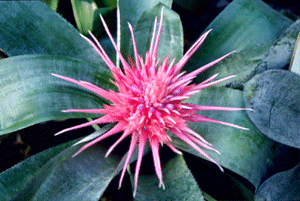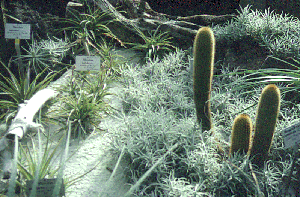Greenhouses - House G
|
In the bromeliad house the display of epiphytic bromeliads may almost make you feel like looking into the canopy of a neotropical forest. The most sunny corner of the glasshouse is occupied by Bromeliaceae of more arid regions.
Bromeliads are perennial plants, often forming rosettes with or without elongated trunk. The majority lives without contact to the soil as epiphytes on trees and shrubs, some also on rocks. Many bromeliads are tank epiphytes. They collect and take up water and nutrients in a dense rosette formed by the leaves. The only function of their roots is to grab hold on the branches and tree trunks they live on. The largest tank epiphytes can be found in the genera Alcantarea and Vriesea. The tanks hold up to 15 liters of water. In cultivation, large species like Alcantarea imperialis take about 15-20 years from seed or offsets to flower.
Other bromeliads root in the soil, like Pitcairnia species with grass-like leaves. More or less succulent plants like Hechtia, Dyckia and Puya occur in arid areas. They take up water through their roots. The only crop plant of world wide importance is Ananas comosus, the pineapple. The largest genus of the family is Tillandsia. Some species commonly growing as epiphytes on tree branches and on candelabrifom cacti are even capable to live on telephone wires, clear evidence that these plants cannot be classified as parasites. The long beards of the "Spanish moss" or "Lousiana moss", Tillandsia usneoides, form practically no roots and take up moisture through the scaly hairs on the surface of the leaves. It seems strange that this plant of the habit of a lichen belongs to the same family as the pineapple plant (Ananas comosus). Our larger "beards" of Tillandsia usneoides are already more than 30 years old. Photo right: Guzmania sanguinea.
About 700 species from 40 genera are represented in this glasshouse. Some other plants often growing together with bromeliads can be found here as well, particularly some epiphytic Cactaceae (Rhipsalis), and some epiphytic ant plants. An interesting simulator of bromeliads is the tank epiphyte Cochliostema odoratissimum of the family Commelinaceae. Photo left: Fog oasis - Tillandsia spp. and Haageocereus. B. Leuenberger |
Continue the tour of the greenhouses...

 The family of the Bromeliaceae has about 50 genera and more than 2600 species (according to estimates made in 1995). Many of them have been described only in recent times. The geographical distribution ranges from SE North America over Central America and the Caribbean to southern South America (Chile and Argentina). In the tropics, bromeliads occur from the lowland to over 4000 m (in the Andes) and they are found in diverse habitats including tropical rainforests, fog and cloud forests, pine and oak forest of Mexico, savanna and dry forest areas, the coastal deserts of Peru, and the high Andean valleys. Photo left: Aechmea fasciata.
The family of the Bromeliaceae has about 50 genera and more than 2600 species (according to estimates made in 1995). Many of them have been described only in recent times. The geographical distribution ranges from SE North America over Central America and the Caribbean to southern South America (Chile and Argentina). In the tropics, bromeliads occur from the lowland to over 4000 m (in the Andes) and they are found in diverse habitats including tropical rainforests, fog and cloud forests, pine and oak forest of Mexico, savanna and dry forest areas, the coastal deserts of Peru, and the high Andean valleys. Photo left: Aechmea fasciata.
 Bromeliads occurring naturally as epiphytes on cacti are shown here on a candelabriform cactus (Cereus) and on leaf-bearing trees of Pereskia from the Caribbean. Tillandsia species from the coastal fog desert of Peru and some Dyckia species and other genera from the dry forest areas of Brazil are shown on the dry side of the bromeliad house.
Bromeliads occurring naturally as epiphytes on cacti are shown here on a candelabriform cactus (Cereus) and on leaf-bearing trees of Pereskia from the Caribbean. Tillandsia species from the coastal fog desert of Peru and some Dyckia species and other genera from the dry forest areas of Brazil are shown on the dry side of the bromeliad house.